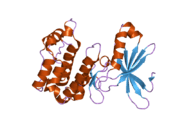Protein kinase, AMP-activated, alpha 1
| View/Edit Human | View/Edit Mouse |
5'-AMP-activated protein kinase catalytic subunit alpha-1 is an enzyme that in humans is encoded by the PRKAA1 gene.[3][4]
The protein encoded by this gene belongs to the ser/thr protein kinase family. It is the catalytic subunit of the 5'-prime-AMP-activated protein kinase (AMPK). AMPK is a cellular energy sensor conserved in all eukaryotic cells. The kinase activity of AMPK is activated by the stimuli that increase the cellular AMP/ATP ratio. AMPK regulates the activities of a number of key metabolic enzymes through phosphorylation. It protects cells from stresses that cause ATP depletion by switching off ATP-consuming biosynthetic pathways. Alternatively spliced transcript variants encoding distinct isoforms have been observed.[4]
Interactions
Protein kinase, AMP-activated, alpha 1 has been shown to interact with TSC2.[5][6]
References
- ↑ "Human PubMed Reference:".
- ↑ "Mouse PubMed Reference:".
- ↑ Stapleton D, Mitchelhill KI, Gao G, Widmer J, Michell BJ, Teh T, House CM, Fernandez CS, Cox T, Witters LA, Kemp BE (Feb 1996). "Mammalian AMP-activated protein kinase subfamily". J Biol Chem. 271 (2): 611–4. doi:10.1074/jbc.271.2.611. PMID 8557660.
- 1 2 "Entrez Gene: PRKAA1 protein kinase, AMP-activated, alpha 1 catalytic subunit".
- ↑ Inoki, Ken; Zhu Tianqing; Guan Kun-Liang (Nov 2003). "TSC2 mediates cellular energy response to control cell growth and survival". Cell. United States. 115 (5): 577–90. doi:10.1016/S0092-8674(03)00929-2. ISSN 0092-8674. PMID 14651849.
- ↑ Shaw, Reuben J; Bardeesy Nabeel; Manning Brendan D; Lopez Lyle; Kosmatka Monica; DePinho Ronald A; Cantley Lewis C (Jul 2004). "The LKB1 tumor suppressor negatively regulates mTOR signaling". Cancer Cell. United States. 6 (1): 91–9. doi:10.1016/j.ccr.2004.06.007. ISSN 1535-6108. PMID 15261145.
Further reading
- Munday MR, Campbell DG, Carling D, Hardie DG (1988). "Identification by amino acid sequencing of three major regulatory phosphorylation sites on rat acetyl-CoA carboxylase.". Eur. J. Biochem. 175 (2): 331–8. doi:10.1111/j.1432-1033.1988.tb14201.x. PMID 2900138.
- Woods A, Cheung PC, Smith FC, et al. (1996). "Characterization of AMP-activated protein kinase beta and gamma subunits. Assembly of the heterotrimeric complex in vitro.". J. Biol. Chem. 271 (17): 10282–90. doi:10.1074/jbc.271.48.30517. PMID 8626596.
- Hawley SA, Davison M, Woods A, et al. (1996). "Characterization of the AMP-activated protein kinase kinase from rat liver and identification of threonine 172 as the major site at which it phosphorylates AMP-activated protein kinase.". J. Biol. Chem. 271 (44): 27879–87. doi:10.1074/jbc.271.44.27879. PMID 8910387.
- Stapleton D, Woollatt E, Mitchelhill KI, et al. (1997). "AMP-activated protein kinase isoenzyme family: subunit structure and chromosomal location.". FEBS Lett. 409 (3): 452–6. doi:10.1016/S0014-5793(97)00569-3. PMID 9224708.
- Velasco G, Gómez del Pulgar T, Carling D, Guzmán M (1998). "Evidence that the AMP-activated protein kinase stimulates rat liver carnitine palmitoyltransferase I by phosphorylating cytoskeletal components.". FEBS Lett. 439 (3): 317–20. doi:10.1016/S0014-5793(98)01400-8. PMID 9845345.
- Crute BE, Seefeld K, Gamble J, et al. (1999). "Functional domains of the alpha1 catalytic subunit of the AMP-activated protein kinase.". J. Biol. Chem. 273 (52): 35347–54. doi:10.1074/jbc.273.52.35347. PMID 9857077.
- da Silva Xavier G, Leclerc I, Salt IP, et al. (2000). "Role of AMP-activated protein kinase in the regulation by glucose of islet beta cell gene expression.". Proc. Natl. Acad. Sci. U.S.A. 97 (8): 4023–8. doi:10.1073/pnas.97.8.4023. PMC 18135
 . PMID 10760274.
. PMID 10760274. - Hallows KR, Raghuram V, Kemp BE, et al. (2000). "Inhibition of cystic fibrosis transmembrane conductance regulator by novel interaction with the metabolic sensor AMP-activated protein kinase.". J. Clin. Invest. 105 (12): 1711–21. doi:10.1172/JCI9622. PMC 378514
 . PMID 10862786.
. PMID 10862786. - Zhang QH, Ye M, Wu XY, et al. (2001). "Cloning and functional analysis of cDNAs with open reading frames for 300 previously undefined genes expressed in CD34+ hematopoietic stem/progenitor cells.". Genome Res. 10 (10): 1546–60. doi:10.1101/gr.140200. PMC 310934
 . PMID 11042152.
. PMID 11042152. - Chen ZP, McConell GK, Michell BJ, et al. (2000). "AMPK signaling in contracting human skeletal muscle: acetyl-CoA carboxylase and NO synthase phosphorylation.". Am. J. Physiol. Endocrinol. Metab. 279 (5): E1202–6. PMID 11052978.
- Blázquez C, Geelen MJ, Velasco G, Guzmán M (2001). "The AMP-activated protein kinase prevents ceramide synthesis de novo and apoptosis in astrocytes.". FEBS Lett. 489 (2-3): 149–53. doi:10.1016/S0014-5793(01)02089-0. PMID 11165240.
- Diggle TA, Subkhankulova T, Lilley KS, et al. (2001). "Phosphorylation of elongation factor-2 kinase on serine 499 by cAMP-dependent protein kinase induces Ca2+/calmodulin-independent activity.". Biochem. J. 353 (Pt 3): 621–6. doi:10.1042/0264-6021:3530621. PMC 1221608
 . PMID 11171059.
. PMID 11171059. - Wang X, Li W, Williams M, et al. (2001). "Regulation of elongation factor 2 kinase by p90(RSK1) and p70 S6 kinase.". EMBO J. 20 (16): 4370–9. doi:10.1093/emboj/20.16.4370. PMC 125559
 . PMID 11500364.
. PMID 11500364. - Xi X, Han J, Zhang JZ (2001). "Stimulation of glucose transport by AMP-activated protein kinase via activation of p38 mitogen-activated protein kinase.". J. Biol. Chem. 276 (44): 41029–34. doi:10.1074/jbc.M102824200. PMID 11546797.
- Fryer LG, Foufelle F, Barnes K, et al. (2002). "Characterization of the role of the AMP-activated protein kinase in the stimulation of glucose transport in skeletal muscle cells.". Biochem. J. 363 (Pt 1): 167–74. doi:10.1042/0264-6021:3630167. PMC 1222463
 . PMID 11903059.
. PMID 11903059. - Yang CS, Weiner H (2002). "Yeast two-hybrid screening identifies binding partners of human Tom34 that have ATPase activity and form a complex with Tom34 in the cytosol.". Arch. Biochem. Biophys. 400 (1): 105–10. doi:10.1006/abbi.2002.2778. PMID 11913976.
- Bolster DR, Crozier SJ, Kimball SR, Jefferson LS (2002). "AMP-activated protein kinase suppresses protein synthesis in rat skeletal muscle through down-regulated mammalian target of rapamycin (mTOR) signaling.". J. Biol. Chem. 277 (27): 23977–80. doi:10.1074/jbc.C200171200. PMID 11997383.
- Esumi H, Izuishi K, Kato K, et al. (2002). "Hypoxia and nitric oxide treatment confer tolerance to glucose starvation in a 5'-AMP-activated protein kinase-dependent manner.". J. Biol. Chem. 277 (36): 32791–8. doi:10.1074/jbc.M112270200. PMID 12091379.
- Horman S, Browne G, Krause U, et al. (2003). "Activation of AMP-activated protein kinase leads to the phosphorylation of elongation factor 2 and an inhibition of protein synthesis.". Curr. Biol. 12 (16): 1419–23. doi:10.1016/S0960-9822(02)01077-1. PMID 12194824.


